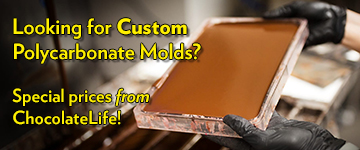Jim, Just so we don't confuse folks:
While it's true that a simple chocolate ganache (cream/chocolate) with an aW below <0.85 is going to take longer to spoil that one at aW >0.9, basically the target of aW<0.85 is to prevent the outgrowth of pathogens (i.e. aW <0.95) and at aW <0.85 inhibit spoilage by most yeasts. Just because a food has a aW <0.85 doesn't mean it is 'stable' just unlikely to harbor pathogens, and less likely to ferment at RT.
Are you making homemade fruit puree? aW 0.93? What's the final pH and the starting and final Brix?
What one can make as a pastry chef and serve 'fresh' to diners versus something that can legally be sold in Interstate or even in-state commerce is of course quite different. Notter's recipes are fine flavoured but are not developed with production, storage and offsite sales in mind.
Regarding your two layer 'jelly' product:
In many States and per the FDA's food safety rules; Jam and Jelly / fruit sryups should have a pH <4.0 and or an aW <0.8 - 0.85 to be regarded as a non-hazardous food stuff. It's my understanding that 'Pate de fruit' made with commercial Brix 10 starting puree and cane sugar typically fits the bill here, given the final Brix after boiling, and low pH levels following pectin/ tartaric / citric acid addition. I've never measured the aW of PdF, but it lasts at RT for months if stored dusted in sugar in sealed containers.
FYI: Outside of the pH and aW parameters above, typically to make and sell legally a 'jelly' in the USA you to need to attend an 'approved food processing school' and follow the FDA rules which most States now also follow as you could be making a potential hazardous food for resale. You also need to register with FDA.
Considering your 'Jelly' layer:
According to the the experts, in certain situations with some foodstuffs the relationship between total moisture content and or aW is not necessarily directly predictive of shelflife. According to the reference materials I have seen, for jams and fruit syrups <0.8 aW is the level necessary to stop most moulds and bacteria such a S. Aureus. Fruit jams (e.g. your pate de fruit layer?) may be such that halophilic bacteria could grow even at just aW 0.75. (hence pH adjustment is typically necessary for ensuring food safety). Did you add acid during production e.g. citric acid with the pectin? When water activity of a food stuff like a gel is likely not a good predictor of shelf life or even protection from microbiological spoilage, a shelf life study and or challenge trial with the formulation to determine food safety /spoilage may be needed.
Plus, in a two layer product one with a component with relatively high moisture content (gel - pate de fruit into ganache?) there may be some water migration, which can both change texture and also allow aquired free water to promote spoilage in another fraction with an initially low aW. I've seen a thin layer of cocoa butter sometimes suggested to prevent migration between layer confections.
Potential Changes to PdF:
Dextrose would lower the aW some, sorbitol would only modestly lower the aW (taste changes) ditto for adding more invert (too sweet?). n.b. You are already getting some invertion of sucrose during the boiling stage assuming you are boiling the fruit? If the pH is <4.X you may already have a 'safe' product... (n.b. not a binding opinion just a projection)
Sidenote: Actually, Glycerol has a greater antimicrobiological effect at the same aW than Sorbitol, hence may commercial praline formulae therefore use both Sorbitol and Glycerol (both taste horrible in ganache in my view,) I'm not sure they would do much in your jelly?)
Several ways to potentially 'improve' this formulation....Drive off some water increasing the Brix of the initial fruit component, use some dextrose as well as sucrose (perhaps you could even use freeze dried fruit), decrease the pH <ph 4.0 using citric acid (legal requirement + may help taste too), add Sorbic acid or better Ca Sorbate to the fruit, consider perhaps adding some Benzoate.
There's science and food safety considerations behind those ingredients one finds on the label. No doubt the militant 'vegan liberation front' will be along shortly to tell us all how they turn green and spotty if they eat chocolates /jam with 'preservatives'...... 
Bottomline: You're perhaps in search of a bit of a unicorn, i.e. A simple formulation without additives that has a 'long shelflife'.
Good Luck
Mark

